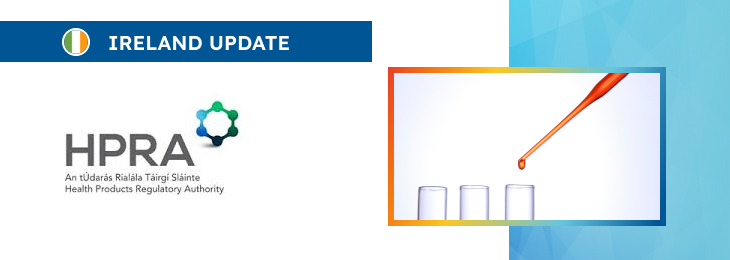The new article elaborates more on the specific frameworks applicable to in-house IVDs allowed for manufacture and use in Ireland.

Table of content
The Health Products Regulatory Authority (HPRA), an Irish agency responsible for medical devices, has published a guidance document dedicated to the manufacture and use of in-house in vitro diagnostic medical devices (IVDs) by health institutions in Ireland. The document describes in detail the relevant regulatory requirements set forth under the existing legal framework and also provides additional clarifications and recommendations to be taken into consideration by medical device manufacturers and other parties involved in order to ensure compliance.
At the same time, the authority also reserves the right to make changes to the guidance and recommendations provided therein, should such changes be reasonably necessary to reflect corresponding amendments to the underlying legislation. In particular, the authority has outlined two frameworks for health institutions in Ireland that manufacture and use in-house in vitro diagnostic medical devices (IVDs).
These frameworks help ensure continuous safety and proper performance of such products, addressing specific patient needs and regulatory compliance.
Framework 1: Standalone In-House IVD
This framework allows health institutions to assess, document, and meet the requirements for each in-house IVD individually, created to address specific needs.
Framework 1 divides the requirements into two separate files:
- Health Institution/Laboratory Level Records: These include overarching policies, procedures, and documents that meet the general requirements outlined in sections 5.2 and 5.6 of the guide.
- IVD-Specific File: This includes a GSPR checklist and supporting documentation for each in-house IVD.
Furthermore, the following requirements must be met at the health institution or laboratory level:
- A policy on the non-transfer of in-house IVDs
- Appropriate Quality Management System (QMS)
- Compliance with EN ISO 15189
- Notifications to the HPRA (sections 5.3 and 5.4 of the guide)
- Process for creating and updating the public declaration
As further explained by the authority, the IVD-Specific File should include:
- A GSPR checklist (Appendix 1)
- Supporting documentation such as intended purpose, risk assessments, instructions for use, and standard operating procedures
- Data on IVD performance from verification, validation activities, or routine clinical use
- For Class D IVDs, additional documentation as outlined in sections 5.2.7 and 5.2.8
- Justification for the use of the IVD, when applicable
- Records of any serious incidents and corrective actions implemented
- Review of experience gained from clinical use
- Requirements for self-testing or near-patient testing IVDs, including design considerations.

Framework 2: Combining or Multiplexing In-House IVDs
The second framework is designed for health institutions that manufacture and use multiple similar in-house IVDs sharing a common workflow or design. It allows leveraging common information to reduce administrative burden.
Framework 2 divides the requirements into three files:
- Health Institution/Laboratory Level Records: Similar to Framework 1.
- Framework File: Documents the common elements and processes for the overarching workflow.
- IVD-Specific File: Covers the remaining requirements specific to each in-house IVD.
Under the second framework, the Health Institution/Laboratory Level Records should include:
- A policy on the non-transfer of in-house IVDs
- Appropriate QMS
- Compliance with EN ISO 15189
- Notifications to the HPRA (sections 5.3 and 5.4)
- Process for creating and updating the public declaration
The Framework File should document common elements and processes, including:
- A GSPR checklist for the overarching framework
- Risk assessments, instructions for use, standard operating procedures, and intended purpose documentation
- For Class D IVDs, additional documentation such as information on the manufacturing facility, process, and IVD design (sections 5.2.7 and 5.2.8)
In its turn, the IVD-Specific File should include:
- A GSPR checklist for remaining IVD-specific requirements
- Data on IVD performance, particularly for combinations and interchangeability of IVDs
- For Class D IVDs, additional documentation on intended purpose and performance
- Justification for the use of the IVD, when applicable
- Records of any serious incidents and corrective actions implemented
- Review of experience gained from clinical use
- Requirements for self-testing or near-patient testing IVDs, including design considerations.
Appendix 1: General Safety and Performance Checklist
The document also contains Appendix 1 which provides a checklist to be used by healthcare institutions involved in the manufacture and use of in-house IVDs in order to assess their compliance with the relevant regulatory requirements. The checklist assists health institutions in achieving compliance with the GSPR outlined in IVDR Annex I. It covers, inter alia, the following matters:
- Chapter I (1-8): General requirements, including risk management and minimization;
- Chapter II (9-19): Requirements regarding performance, design, and manufacture;
- Chapter III (20): Requirements for information supplied with the IVD, including labeling, packaging, and instructions for use.
For instance, the requirements outlined in the checklist include the ones listed below.
- Labeling and Packaging (IVDR Annex I, Sections 20.2-20.3): In-house IVDs should have sufficient information for identification, such as device number, manufacturing date, and internal reference code. This can be achieved through appropriate labeling and packaging.
- Instructions for Use (IVDR Annex I, Section 20.4): Instructions for use may be in the form of protocols or standard operating procedures, covering all relevant aspects of Section 20.4.1. For self-testing IVDs, Section 20.4.2 also applies, ensuring end-use considerations are included in the design and usability.
When it comes to the applicability of requirements, the authority explains that not all requirements in Chapters II and III apply to every in-house IVD. For example, self-testing or near-patient test requirements only apply to those specific tests.
Any non-applicable requirements should be documented in the GSPR checklist with justifications. In summary, the present HPRA guidance provides a comprehensive overview of two regulatory frameworks applicable to in-house IVDs, outlining the key points and also emphasizing the difference between those frameworks.
Conclusion
The guidance also contains a checklist to be used by the parties involved in the manufacture and use of such products in order to ensure compliance with the relevant requirements these products are subject to.
How Can RegDesk Help?
RegDesk is a holistic Regulatory Information Management System that provides medical device and pharma companies with regulatory intelligence for over 120 markets worldwide. It can help you prepare and publish global applications, manage standards, run change assessments, and obtain real-time alerts on regulatory changes through a centralized platform. Our clients also have access to our network of over 4000 compliance experts worldwide to obtain verification on critical questions. Global expansion has never been this simple.

